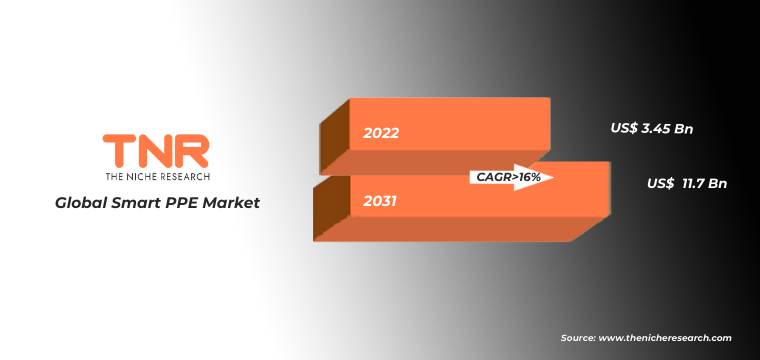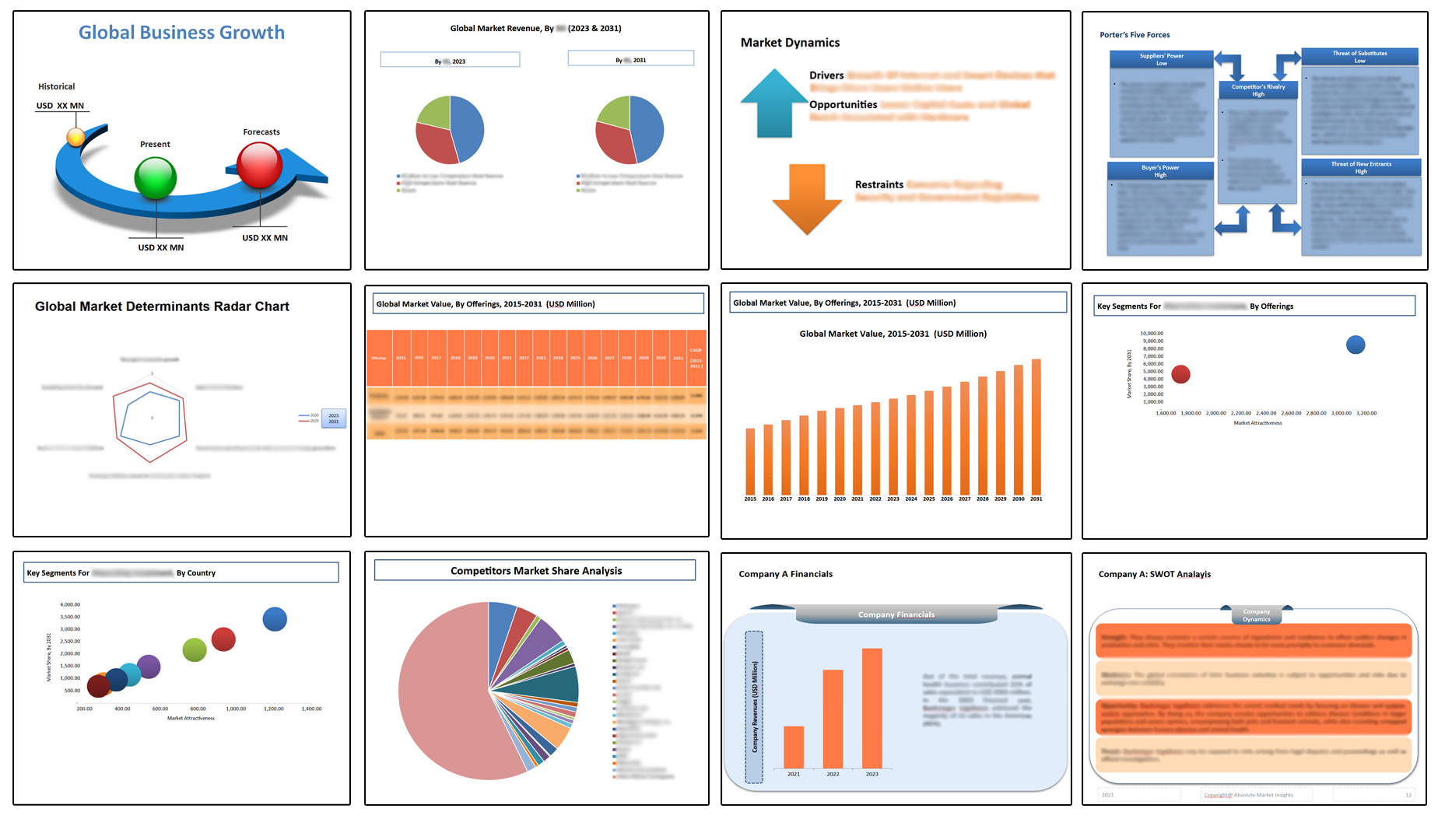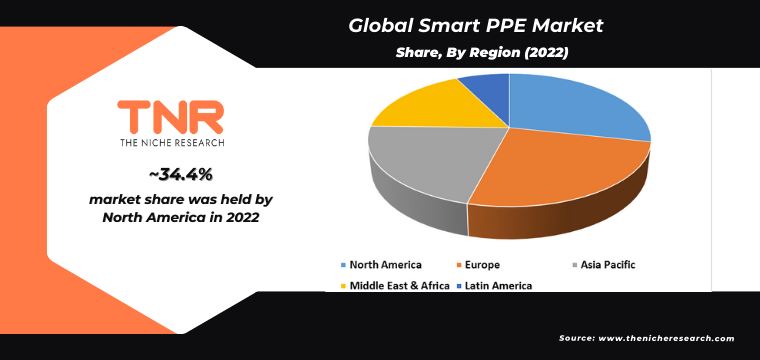Global Smart PPE Market By Product Type, By Distribution Channel, By End Users: Global & Regional Industry Insights Comparative Analysis, Trends and Forecast, 2023 – 2031
- Industry: Technology
- Report ID: TNR-110-1049
- Number of Pages: 420
- Table/Charts : Yes
- December, 2023
- Base Year : 2024
- No. of Companies : 8+
- No. of Countries : 29
- Views : 10209
- Covid Impact Covered: Yes
- War Impact Covered: Yes
- Formats : PDF, Excel, PPT
Global Smart PPE Market Accounted for US$ 3.45 Billion in 2022, Increasing at an Estimated CAGR of 16% from 2023-2031.
Smart PPE is part of a greater effort to create a connected workforce in order to increase safety and operational performance. It refers to smart wearable equipment that links to the internet or other devices like as Bluetooth to give real-time safety information to workers in the field and supervisors on the other end of the queue. Smart PPE, which is frequently in the form of wearables, may track motions, deliver voice messages, check body temperature, provide alarms, and record audio or video communications.
They are frequently combined with a cloud-based analytics platform, as well as a smartphone app. Smart PPE can gather and track hundreds of distinct data points, which may be utilised to address a wide range of safety problems, from fever to heat exhaustion to weariness to inappropriate lifting.
Smart PPE has advanced significantly in recent years, notably with the incorporation of smart sensors and the Internet of Things (IoT). Because of the integration of these technologies, smart PPE devices that can monitor workers’ vitals in real-time and provide essential data on their well-being have been developed. These smart gadgets can monitor a variety of parameters, such as heart rate, body temperature, and tiredness levels, and may notify both the wearer and supervisors to potential health dangers.
Global Smart PPE Market Revenue & Forecast, (US$ Million), 2015 – 2031

Global Smart PPE Market Future
Since the smart PPE industry has transformed drastically over the last decade, there is a profusion of devices, textiles, and platforms. Smart technology areas in personal protection equipment firms are also quickly growing. Rapid expansion implies that more organisations are offering more options and more technology to safeguard workers. However, the future of smart PPE seems far more promising, with increasingly advanced wearable devices expected to enter the market shortly. Environmental monitoring clothing, for example, will be able to control body temperature and identify risks such as gases, poisons, and UV radiation.
Report Coverage and Deliverables:

An in-ear gadget used for physiological monitoring of essential vital indicators such as core body temperature, heart rate, oxygen consumption, and mobility (including fall detection) is one example of wearable smart PPE already in use in the field. The in-ear gadget also includes two-way audio communication and hearing protection as well as ambient sound transparency.
The mining sector is currently employing location devices to track miners. New smart mining helmets are being created, allowing people to speak with the miners and virtually view what they see. Firefighters can see through smoke using gas masks equipped with thermal cameras that use heat rather than light. Although thermal cameras are not new, incorporating one inside a mask provides firefighters with new hands-free technology to keep them and people they protect safe.

North America, particularly the United States and Canada, has well-established and stringent safety regulations across various industries which has led to prominent position of North America in the smart PPE market. Besides North America has a diverse and robust industrial sector, including manufacturing, construction, mining, healthcare, and more. These industries require high-quality protective equipment, and the adoption of smart PPE is driven by the need to mitigate risks, improve productivity, and adhere to safety standards.
Competitive Landscape: Global Smart PPE Market
- ANSELL LTD
- Gaurdhat
- Hexoskin
- Honeywell International Inc
- KINETIC
- Mackwell Health
- ProGlove
- uvex group
- Vuzix
- Other Industry Participants
Report Summary of Global Smart PPE Market
| Report Specifications | Details |
| Market Revenue in 2022 | US$ 3.45 Billion |
| Market Size Forecast by 2031 | US$11.7 Billion |
| Growth Rate (CAGR) | 16% |
| Historic Data | 2015 – 2021 |
| Base Year for Estimation | 2022 |
| Forecast Period | 2023 – 2031 |
| Report Inclusions | Market Size & Estimates, Market Dynamics, Competitive Scenario, Trends, Growth Factors, Market Determinants, Key Investment Segmentation, Product/Service/Solutions Benchmarking |
| Segments Covered | By Product Type, By Distribution Channel, By End Users |
| Regions Covered | North America, Europe, Asia Pacific, Middle East & Africa, Latin America |
| Countries Covered | U.S., Canada, Mexico, Rest of North America, France, The UK, Spain, Germany, Italy, Nordic Countries (Denmark, Finland, Iceland, Sweden, Norway), Benelux Union (Belgium, The Netherlands, Luxembourg), Rest of Europe, China, Japan, India, New Zealand, Australia, South Korea, Southeast Asia (Indonesia, Thailand, Malaysia, Singapore, Rest of Southeast Asia), Rest of Asia Pacific, Saudi Arabia, UAE, Egypt, Kuwait, South Africa, Rest of Middle East & Africa, Brazil, Argentina, Rest of Latin America |
| Key Players | ANSELL LTD, Gaurdhat, Hexoskin, Honeywell International Inc, KINETIC, Mackwell Health, ProGlove, uvex group, Vuzix, Other Industry Participants |
| Customization Scope | Customization allows for the inclusion/modification of content pertaining to geographical regions, countries, and specific market segments. |
| Pricing & Procurement Options | Explore purchase options tailored to your specific research requirements |
| Contact Details | Consult With Our Expert
Japan (Toll-Free): – +81 663-386-8111 South Korea (Toll-Free): – +82-808- 703-126 Saudi Arabia (Toll-Free): – +966 800 850 1643 United States: +1 302-232-5106 United Kingdom: +447537105080 E-mail: askanexpert@thenicheresearch.com
|
Global Smart PPE Market:
By Product Type
- Smart Helmet
- Smart Glasses
- Smart Gloves
- Smart Clothing
- Smart Respirator
- Smart Footwear
- Smart Earmuffs
- Others
By Distribution Channel
- Online
- Offline
By End Users
- Healthcare
- Oil and Gas
- Manufacturing
- Transportation
- Mining
- Forestry
- Chemical
- Energy and Utilities
- Others
By Region
- North America (U.S., Canada, Mexico, Rest of North America)
- Europe (France, The UK, Spain, Germany, Italy, Nordic Countries (Denmark, Finland, Iceland, Sweden, Norway), Benelux Union (Belgium, The Netherlands, Luxembourg), Rest of Europe)
- Asia Pacific (China, Japan, India, New Zealand, Australia, South Korea, Southeast Asia (Indonesia, Thailand, Malaysia, Singapore, Rest of Southeast Asia), Rest of Asia Pacific)
- Middle East & Africa (Saudi Arabia, UAE, Egypt, Kuwait, South Africa, Rest of Middle East & Africa)
- Latin America (Brazil, Argentina, Rest of Latin America)
Table of Contents
Global Smart PPE Market:
By Product Type
By Distribution Channel
By End Users
By Region
The Niche Research approach encompasses both primary and secondary research methods to provide comprehensive insights. While primary research is the cornerstone of our studies, we also incorporate secondary research sources such as company annual reports, premium industry databases, press releases, industry journals, and white papers.
Within our primary research, we actively engage with various industry stakeholders, conducting paid interviews and surveys. Our meticulous analysis extends to every market participant in major countries, allowing us to thoroughly examine their portfolios, calculate market shares, and segment revenues.
Our data collection primarily focuses on individual countries within our research scope, enabling us to estimate regional market sizes. Typically, we employ a bottom-up approach, meticulously tracking trends in different countries. We analyze growth drivers, constraints, technological innovations, and opportunities for each country, ultimately arriving at regional figures.Our process begins by examining the growth prospects of each country. Building upon these insights, we project growth and trends for the entire region. Finally, we utilize our proprietary model to refine estimations and forecasts.
Our data validation standards are integral to ensuring the reliability and accuracy of our research findings. Here’s a breakdown of our data validation processes and the stakeholders we engage with during our primary research:
- Supply Side Analysis: We initiate a supply side analysis by directly contacting market participants, through telephonic interviews and questionnaires containing both open-ended and close-ended questions. We gather information on their portfolios, segment revenues, developments, and growth strategies.
- Demand Side Analysis: To gain insights into adoption trends and consumer preferences, we reach out to target customers and users (non-vendors). This information forms a vital part of the qualitative analysis section of our reports, covering market dynamics, adoption trends, consumer behavior, spending patterns, and other related aspects.
- Consultant Insights: We tap into the expertise of our partner consultants from around the world to obtain their unique viewpoints and perspectives. Their insights contribute to a well-rounded understanding of the markets under investigation.
- In-House Validation: To ensure data accuracy and reliability, we conduct cross-validation of data points and information through our in-house team of consultants and utilize advanced data modeling tools for thorough verification.
The forecasts we provide are based on a comprehensive assessment of various factors, including:
- Market Trends and Past Performance (Last Five Years): We accurately analyze market trends and performance data from preceding five years to identify historical patterns and understand the market’s evolution.
- Historical Performance and Growth of Market Participants: We assess the historical performance and growth trajectories of key market participants. This analysis provides insights into the competitive landscape and individual company strategies.
- Market Determinants Impact Analysis (Next Eight Years): We conduct a rigorous analysis of the factors that are projected to influence the market over the next eight years. This includes assessing both internal and external determinants that can shape market dynamics.
- Drivers and Challenges for the Forecast Period:Identify the factors expected to drive market growth during the forecast period, as well as the challenges that the industry may face. This analysis aids in deriving an accurate growth rate projection.
- New Acquisitions, Collaborations, or Partnerships: We keep a close watch on any new acquisitions, collaborations, or partnerships within the industry. These developments can have a significant impact on market dynamics and competitiveness.
- Macro and Micro Factors Analysis:A thorough examination of both macro-level factors (e.g., economic trends, regulatory changes) and micro-level factors (e.g., technological advancements, consumer preferences) that may influence the market during the forecast period.
- End-User Sentiment Analysis: To understand the market from the end-user perspective, we conduct sentiment analysis. This involves assessing the sentiment, preferences, and feedback of the end-users, which can provide valuable insights into market trends.
- Perspective of Primary Participants: Insights gathered directly from primary research participants play a crucial role in shaping our forecasts. Their perspectives and experiences provide valuable qualitative data.
- Year-on-Year Growth Trend: We utilize a year-on-year growth trend based on historical market growth and expected future trends. This helps in formulating our growth projections, aligning them with the market’s historical performance.
Research process adopted by TNR involves multiple stages, including data collection, validation, quality checks, and presentation. It’s crucial that the data and information we provide add value to your existing market understanding and expertise. We have also established partnerships with business consulting, research, and survey organizations across regions and globally to collaborate on regional analysis and data validation, ensuring the highest level of accuracy and reliability in our reports.









